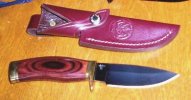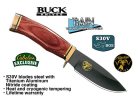I don't mind 420HC, if it's an interesting knife pattern and priced accordingly. Buck fixed blades are a perfect example of what I mean, $40-$50 for the black "phenolic"-handled models. Definitely a favorable materials-to-price ratio.
Another similar example of what I'm trying to say, the CRKT Rollock. They're actually AUS-4, not 420HC, but the two metals perform similarly. Not very good steel, but I think most people buy these primarily for the design anyway. And at $8-$20, who'd complain?
To see an unfavorable price-to-materials ratio, look at the prices of many of the knives from Queen, Schatt & Morgan, and Canal Street Cutlery. For knives in that price range, it's reasonable and fair to expect something better than 420 stainless.
420J2, only suitable for liners. Entirely too soft for a useful knife blade. Just my opinion, of course.


